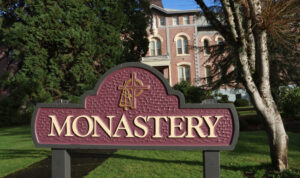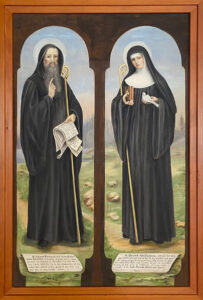By Stephen Floyd
Sister Protasia Schindler’s name comes up in many conversations about the Sisters of Queen of Angels Monastery. Not as an administrator or reformer. Her paintings adorned the halls and helped foster a thriving culture of arts and letters. Even the giant sequoia outside the front steps was her unintentional handiwork.
Schindler’s whimsy and spirited approach to monastic life was felt by those around her, and is still seen today at Queen of Angels.
Schindler’s contributions helped the order define their outlook on faith, even as the Sisters departed the monastery in May. The remaining members have moved to Mount Angel Towers, or Providence Benedictine Orchard House for those needing extra care.
While the order has transitioned out of monastery housing, and their legacy within the community continues. The following draws heavily from A Tree Rooted in Faith by Sister Alberta Dieker, a thoroughly-researched history of the order published in 2007.

Sharing herself in her work
Schindler’s membership in the order began in 1884, just two years after the Benedictine Sisters established themselves in Oregon after immigrating from Switzerland. A Gervais native, Schindler was a student of the nuns. At the age of 14 she became one of the first Americans to join the order.
She was proud of her faith and her community, and was part of efforts to build and adorn the monastery when construction began in 1885. Among her notable contributions were the stations of the cross in the chapel, painted in oil on canvas. Her portraits of St. Benedict and his twin sister St. Scholastica hung in the halls.
Dieker said this art helped tell the story of the Sisters and their 141-year history in Oregon. Though diaries and annals record specific events, there are very few records of the lives and personalities of the Sisters. It is through the works they left behind that we have a glimpse of who they were.
“Certainly each one played a part in her own way, with her own motives and dreams,” said Dieker.
She said Schindler’s work revealed her to be a remarkable artist who was self-taught and drew from inspiration. When describing the painting titled “Mary, Queen of Angels” depicting the Assumption of Mary, Schindler said the many cherubs and angels “just emerged from the clouds” as she painted.

An image of faith
Schindler’s most visible achievement, though she never intended it to be, came in 1893 when she planted the sequoia that grows outside the monastery entrance.
The story goes that Schindler’s was walking along the railroad tracks near the monastery and noticed two saplings, presumably deposited there by seeds from passing lumber trains. She sought help to dig up and replant the trees, and nurtured them using dishwater from the kitchen.
One tree did not survive. The other grew, and grew, and eventually became taller than the monastery, revealing itself to be a giant sequoia. Apparently one conifer sapling looks very much like another to the untrained eye. Schindler later remarked that, if she had known, she would never have planted the tree there.
The sequoia is now one of the hallmarks of the monastery, standing 129 feet tall and celebrating its 130th anniversary this year. It is also the namesake of Dieker’s book. In the forward, former Prioress Dorothy Jean Beyer wrote the sequoia is an apt metaphor of finding strength in the unexpected.
“Our monastic ‘tree’ has been rooted in the faith of our pioneer sisters and grown by courageous, self-sacrificing love,” Beyer wrote.
The next chapter
Schindler died in 1959 at age 89, just before the Sisters entered an era of modern changes that lead to a slow decline in religious orders throughout Catholicism. Laypeople were allowed to serve in ministry without taking vows, and society was affording options to women that were not encouraged in the 19th century.
In 2022, the 16 members remaining Sisters of Queen of Angels made the difficult decision to vacate the monastery and place it in the care of someone who would honor their legacy of community service. Their move was completed in June. Their final Sunday mass at the monastery was July 9.
The future ownership of the monastery and its grounds is still uncertain. Arrangements with Mountain West Investments to develop mixed-density, community-centered housing fell through in April.
Catholic Community Service is one of the potential buyers. Early on CCS committed to overseeing continuing programs at the monastery. It will operate the Mission Benedict resource center and St. Joseph Family Shelter, and will partner with Fr. Bernard Youth Center.
CCS spokesperson Mona Hayes said they will also partner with the Sisters who wish to remain active in ministry, striving to “offer hope and healing” to those in need in the community.
